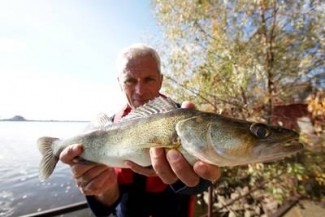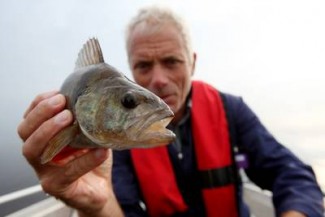INTERVIEW: Jeremy Wade on his memories of catching ‘River Monsters’

Jeremy Wade, star of River Monsters on Animal Planet, has a few fisherman tales to tell. But unlike some yarns about the big ones that got away, Wade’s stories are true.
The former science teacher’s search for the elusive monsters of freshwater rivers has been an enormous success for Animal Planet. The premiere of season five reached a record audience, and the only obstacle that may stop Wade from more adventures is whether there’s enough monsters to discover.
“It was actually a very memorable season to make,” Wade said recently during a phone interview. “You know, our subject matter is finite. So I think at the beginning of the year, we’re scratching our heads. You know, what are we going to film. I think as we go further it makes us think more laterally.”
Along those lines, Wade and his crew head to Chernobyl, the infamous radioactive site, to fish in a cooling pond — not exactly paradise. “If you would have asked me a few years ago if I was going to be fishing anywhere like that, it wouldn’t have been on my list,” he said. “We also looked into the Loch Ness monster. You know, that’s right on my doorstep. I sort of tend to go to rather far-flung places, and here’s the best-known monster myth possibly in the world, and it’s right on my doorstep. Well, maybe it’s time we had a look at that. And that’s a two-hour special. That’s sort of the finale of the season.”
Other season-five highlights include Colombia, Bolivia and southern South America, a region that Wade identifies as his “favorite stomping ground.”
The fisherman doesn’t just look for unusual species; he also tries to unearth new details on “monsters” that have already been featured on the show. His upcoming Colombia episode looks at sting-rays and their behavior.
“I think the pressure is more in the individual programs because if we don’t actually get a fish at the end of it, then we don’t really have a film,” he said. “People are fascinated with predators. I think that’s part of the success of the program. We’re hard-wired to be interested in predators.”

Wade said the TV shoots for each episode are generally two to three weeks long, with only a few days spent fishing. The rest of the time he’s prepping and doing his homework. If he didn’t have the obstacles of a TV production, Wade would probably spend more time in each location.
“I’d probably go for two or three months and actually immersing myself in the culture in the place. We can’t do that when we’re filming. I mean budgets and just demands of getting a certain number of programs. So it’s a bit more high pressure. On the plus side, I get to see a lot more places than I would [not] have done otherwise. There’s no way I would have gone to all these places just doing it on my own. The other thing is, when I fish, it’s normally a solitary activity. So having an entourage of four or five people, it’s a bit strange. … They’re there, but when I’m in the zone, I’m not particularly aware of them.”
Wade, who seems to have a perfect last name for this career path, appreciates the fears of the audience, our collective weariness over what lurks beneath. “So you don’t hide away and not confront anything,” he said. “On the other hand, you don’t try and destroy the thing that you’re afraid of. You know, I don’t kill these animals. I put them back alive having looked at them. It’s all about understanding them, understanding their behavior.”
The dangers don’t always swim within the river. Wade’s crew has been struck by lightning, and prior to River Monsters, he even survived a small plane crash. “I was in a light plane, single-engine plane over the Amazon, and we lost the engine,” he said. “So that came down in the forest. And that was, again, one of those sort of random, unpredictable events. … There were five of us on board, and we all walked away unscathed. … It’s being prepared I think for the unexpected, particularly for places where you haven’t got people who can come help you. You’re several hours away from any kind of help.”
The future of River Monsters is in question. Despite its wild success, subject matter for future episodes is drying up. “It can’t continue in its present form forever, simply because the number of animals that we can deal with is finite,” he said. “We’re talking about apex predators. So apex predators aren’t very numerous anyway. All of the small fish are quite numerous. And also there is a conservation issue in that we possibly give the impression that everywhere you go that’s a bit remote, there are these huge fish that might bite your leg off. In fact, just in the last 50 years, the numbers of fish have declined, and it’s actually very hard, even if you know about certain fish, to actually find a place where realistically you’ve got a chance of producing one in a couple of weeks.”
Still, any fisherman needs to relish the past, needs to have that quintessential yarn. What’s the best catch of all time? Wade, without hesitation, has got a golden story about a goliath tigerfish in the Congo.
“I first went to that part of the world, what’s now Democratic Republic of Congo, what was then Zaire, 25 years before I went there with a camera crew,” he said. “And I was there for two months. I caught nothing. Had a bit of a nightmare trip. I went back again to the same general area a few years later — nothing at all. Caught malaria very badly, almost died in fact. Went back again, caught a medium-sized one. But that was a case of unfinished business. I want a big one of these fish. So it was a real gamble to go there with a crew. I knew it was doable, but actually catching a big one of these fish that was nearly 80 pounds with a camera crew, 25 years after I first went to that part of the world, I think that’s going to take a lot of beating.”
By John Soltes / Publisher / John@HollywoodSoapbox.com


Re ALigator Gar in the river -. 1960+-3yrs inHouston,On Braes Bayou (an excavated drainage channel) just east of the now Fondren Rd, I was walking up-steam with water about 3 ft wide and 2 ft deep and was surpised by an aligator gar that was facing up-stream and reared up almost vertically and floped down heading down- stream, striking mye left sholder lightly. Its length was more than my height > 6 ft,2
1965+-3yrs- The bridge on Main street over Braes Bauou was beig reconstructed with a very large Aligator Garr hung from the bridge.
gf